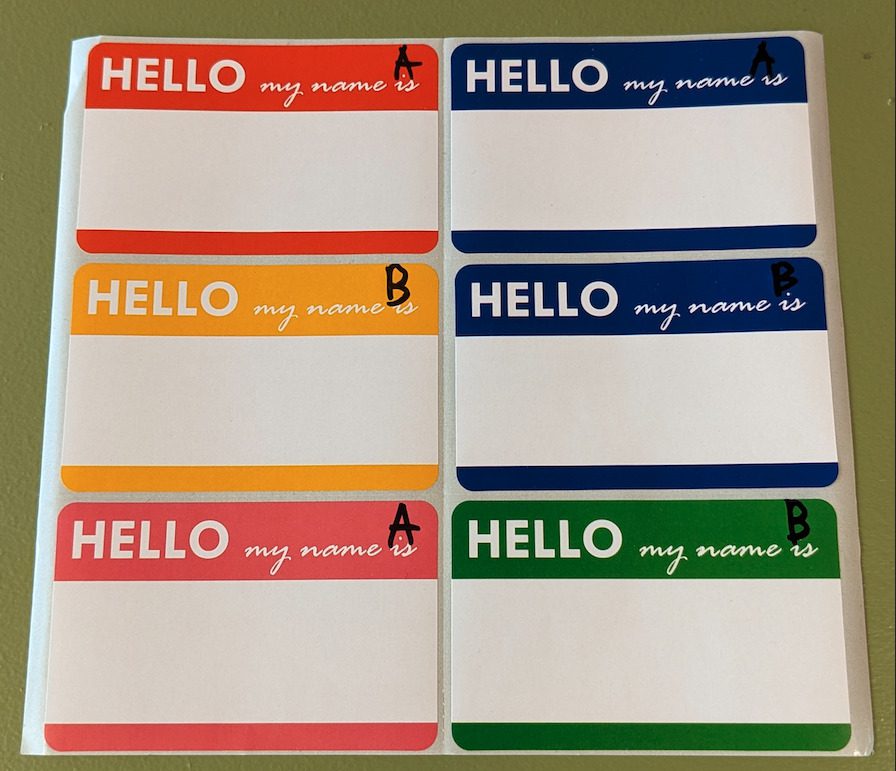Last updated: September 25, 2024
You can use name tag games to organize different groupings of your guests at a party. I like doing this especially for larger parties, or for events where I want to facilitate more small-group conversations.
Your guests will split up based on letters, numbers, shapes, or other marks on their name tags.
This article will outline why you might want to do that and exactly how to set up the activity.
Why you should listen to me: I have hosted hundreds of parties, thousands of icebreakers, and written tens of thousands of name tags. I even wrote a book about how to host a party. For this article, I interviewed two successful Meetup hosts and tested the techniques.Estimate Group Size
First, make your best guess as to how many people will attend your party.
This activity works best with a minimum of 10 people. It could theoretically scale up to groups as large as 50!
Next, determine how many groups you want, or how many people you want in each group. I’ve found that the ideal group size is about four to six people. Anything larger than six is harder to self-organize.
This article will discuss several key learning concepts from my book The 2-Hour Cocktail Party, including Name Tags: How and Why to Use Them and The Ultimate Icebreaker Guide.
Easy: Two Large Groups
For half of the name tags, write the group letter “A” in the top right corner. For the other half of the name tags, write the letter “B” in the same top right corner.
You’ll have two stacks of name tags, blank except for these numbers, which will look like this:

March 2024 Update: I have a new favorite. It’s the Cualfec 300 Cute Dot Name Tag Stickers. Sadly my last favorite the Cualfec 210s have gone out of stock and I cannot get in touch with the manufacturer. We use the different colors for events to randomly split people up into small groups.
For this round of icebreakers, say the following to your party guests:
“Everyone with an “A” on their name tag please stand on this side of the room. Everyone with a “B” please stand on that side of the room.”
Then explain your icebreaker questions and give a demonstration.
Now you will hop between the two groups to facilitate your guests, move the questions along, and keep track of timing.
My favorite beginner icebreaker question to use for this name tag game is: What’s one of your favorite things to eat for breakfast? See my article on Icebreaker Best Practices for why this works well.
Harder: Multiple Groups
To have more than two groups, write “A”, ”B”, “C” and “D” on your name tags before handing them out, or however many groups you’d like.
When it’s time for icebreakers, separate the groups into different corners of the room. Explain the questions and give a quick demo.
Make sure to continuously hop around to facilitate each different group.
Another way you can do this is by breaking people up by the color of their name tags.
In this video, I demonstrate how to do this with a large group.
Hardest: Multiple Groups for Multiple Rounds
This works best for parties with 16+ guests. I recommend this to experienced party hosts only!
It is the same as the “multiple groups” version, except when you do a 2nd round of group icebreakers, each group will have different guests than the 1st time. Here are the steps:
- Estimate how many guests will attend.
- Determine how many groups you want and amount of people per group. (For this example, I’m assuming 16 attendees, so four groups of four.)
- Write “A1”, “A2”, “A3”, and “A4” on name tags, then continue this for “B”, “C”, and “D”.
- For the 1st round of group icebreakers, have guests meet up based on their letters.
- For the 2nd round of group icebreakers, have guests meet up based on their numbers.
Pro tip: If you want a third and fourth round, add shapes and/or Roman numerals to the name tags.
Conclusion
Name tag games are an advanced facilitation technique that can help you automate some of the mixing and mingling at your party. Use this activity when you have at least 10 attendees at your party.
Your guests will love the socializing dynamics that smaller groups provide.
Remember to do these things to ensure it is successful:
- Decide the size of your groups beforehand
- Write different marks on name tags before handing them out
- Divide the room based on their nametag markings for group icebreakers
A special thank you to Lauren in Denver and Cassandra (Lauren’s friend) for providing me with an outline for this activity.
Making friends as an adult is something that is not taught in school. Tons of you meet plenty of interesting people, but don’t have a way to connect with them conveniently. Check out the book that I wrote and download the first few chapters for free to see exactly how to host a 2-hour cocktail party.


